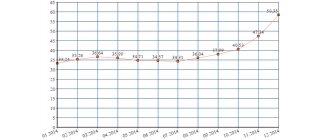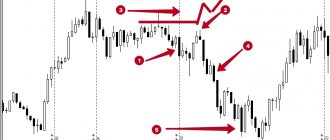In Russia, all traders can be divided into 2 groups: those who start trading from the international currency market (Forex) and those who start trading from the stock exchange (stock market, FORTS derivatives market and Russian foreign exchange market). Both groups are on opposite sides of the barricade and do not accept the opposite type of trade. But some, over time, switch from one side to the other, and most often this is a transition from Forex to the Russian stock market. Often, a trader, having tried his hand at the stock market, moves on to the next link - the Russian foreign exchange market.
The currency section on the Russian exchange provides the opportunity to trade instruments paired with the ruble. Therefore, the most common assets are: USD/RUB and EUR/RUB.
And here a new surprise appears, unlike the Forex market, on the Russian currency exchange each currency has two trading pairs and each has its own chart, but with one difference - a small difference in quotes (it can be 5 or 75 kopecks). That is, the USD/RUB currency has two pairs: USD/RUB Tod and USD/RUB Tom.
What are TOM and TOD
USD/RUB Tod (Today) means today's settlement rate, and USD/RUB Tom (Tomorrow) means tomorrow's, this is a kind of forecast of the exchange rate for tomorrow. But it is symbolic, and if an important economic event occurs that can affect the price, the course will change.
The difference in price at one point in time between TOM and TOD can be different, both in value and in direction. The USD/RUB Tod rate may be 65.25 rubles, while the USD/RUB Tom rate will be higher and amount to 65.65. Conversely, the TOD rate may be greater than the TOM rate. It all depends on the current market situation.
When a trader first sees the difference in prices between TOM and TOD, he has the idea to buy 1000 dollars on the USD/RUB Tod pair, for example, at a price of 66.50 rubles, and then sell this 1000 on the USD/RUB Tom pair, which has a price of the same point in time 66.70. After all, the currency is the same! Thus, a trader in such a situation plans to receive 20 kopecks of profit from every dollar almost out of the blue. But!
Tools of currency speculators
Today, the dollar to ruble exchange rate again reached a historical high, rising to 38 rubles.
In this regard, Financial One reminds readers about the main instruments of the foreign exchange market of the Moscow Exchange, which allow you to make money on fluctuations in exchange rates.
1.
Spot Transactions
First of all, it is worth remembering spot foreign exchange transactions - transactions in which two parties exchange two different currencies at an agreed exchange rate with settlement in two business days. This time interval was previously due to objective technical difficulties, but with the development of electronic communications, calculations began to be carried out faster.
The Moscow Exchange carries out spot deals at the Today rate with currency delivery on the day the deal is concluded, and spot deals at the Tomorrow rate with the condition of currency delivery the next day after the deal is concluded. The parameters of spot transactions are established by the Moscow Exchange in agreement with the clearing center. The following instruments are used for trading US dollars for Russian rubles: USDRUB_TOD, USDRUB_TOM, USDRUB_SPT, USDRUB_LTV.
USDRUB_TOD is an instrument, when buying or selling which involves the purchase and sale of funds in US dollars in lots for Russian rubles during trading in US dollars for Russian rubles with the deadline for fulfilling obligations on the day of trading. Accordingly, when using USDRUB_TOM, the deadline for fulfilling obligations is set on the first business day after the auction.
The bid price for both instruments is determined accurate to the fourth decimal place per $1, the price increment is 0.0005 rubles.
USDRUB_SPT differs from them in that when it is used, settlement is carried out on the second day after the auction. By choosing USDRUB_LTV, you can expect to receive a settlement no earlier than the second calendar day and no later than the 366th calendar day from the date of fulfillment of obligations under transactions with the USDRUB_TOM instrument concluded on the same day. The bid price for both instruments is determined accurate to the fourth decimal place per $1, the price increment is 0.0001 rubles.
2.
Swap transactions
This type of transaction is a combination of spot and forward transactions: buying through a spot transaction and selling through a forward transaction. The essence of the latter is that the seller undertakes to transfer currency to the buyer after a certain period of time, and the buyer undertakes to accept it and pay in accordance with the terms of the transaction.
The mechanism for concluding swap transactions is as follows: foreign currency purchased under a spot transaction is sold after a certain period, and accordingly, the currency sold under a spot transaction is purchased again at a later date. Both transactions are concluded with the same partner, with rates, value dates and payment methods set at the time the transaction is concluded. For trading in US dollars for Russian rubles, the following instruments are defined: USD_TODTOM, USD_TOMSPT, USD_TOM1W, USD_TOM2W, USD_TOM1M, USD_TOM2M, USD_TOM3M, USD_TOM6M, USD_TOM9M, USD_TOM1Y.
As an example, consider USD_TODTOM – a swap transaction consisting of the simultaneous purchase or sale of the USDRUB_TOD instrument and the sale or purchase of the USDRUB_TOM instrument. The price of orders for this instrument is determined accurate to the fourth decimal place per $1, the price step for USD_TODTOM swap transactions is 0.0001 rubles. For USD_TODTOM swap transactions, the base rate is the central rate of transactions for the purchase and sale of US dollars for Russian rubles, determined on the date of trading.
3.
Futures contracts for the dollar/ruble pair
Currently, 5 settlement futures contracts for the US dollar versus ruble exchange rate are traded on the Moscow Exchange with expiration in September 2014 (SiU4), December 2014 (SiZ4), March 2015 (SiH5), June 2015 (SiM5) and September 2015 (SiU5). Each contract is quoted in rubles based on a lot size of $1000, with variation margin calculated and paid from the first day of the contract to the last day of the contract, inclusive. Let us remind you that the last day on which you can make transactions with contracts is the 15th day of the corresponding month or the first trading day after it if the market is closed on the fifteenth day. That is, the nearest September contract will expire today. Interestingly, the contracts indicate that market participants see the dollar exchange rate above 40 rubles in a year.
The amount of guarantee security (GS) for the September contract currently amounts to 1,696 rubles. At the same time, the exchange has established the following fees: for registering a transaction - 0.5 rubles, for a scalper transaction - 0.25 rubles, for an address transaction - 0.5 rubles, for contract execution - 1 ruble.
Values from the order book of futures contracts (as of Friday, September 12)
| Expiration date | Purchase | Sale |
| September 2014 | 37 893 | 37 895 |
| December 2014 | 38 584 | 38 588 |
| March 2015 | 39 308 | 39 325 |
| June 2015 | 40 090 | 40 115 |
| September 2015 | 40 300 | 40 700 |
4.
Options on futures contracts of a currency pair
Many margined options on futures contracts at the dollar versus ruble exchange rate with expiration every month. Let us remind you and give an example of how the names of instruments are deciphered on the Moscow Exchange. “Si-12.14M151214CA 38000” means that the underlying asset of this contract is the SiZ4 futures, the contract itself is margined and expires on December 15, 2014, and the contract type is an American call (to buy) with an execution price of 38 thousand rubles.
But there's a catch ahead!
Technically, this is feasible - open a buy on USD/RUB Tod and immediately open a sell on USD/RUB Tom. However, these will be 2 unrelated positions, and opening each of them will require a margin and payment of a commission. They will “live” until the orders are closed, and if leverage is used in trading, then for each day these transactions exist, the broker will charge not only a commission, but also a leverage fee. As a result, the costs of transactions will cover the profits from them.
It would seem that the positive result of one transaction will cover the negative result of another (after all, these are 2 pairs of the same currency!) and the initial level of funds will not change. But stock trading has many small details that you need to know before you start speculating.
Broker to help
The Moscow Exchange does not work directly with individuals. You will need a broker. He will also take money for services, but the markup will be minimal, since the broker is not an intermediary, but rather a service department. The difference is roughly the same as between booking a hotel through a travel agency and a specialized website. For example, according to statistics, the average commission is 0.013% of the exchange amount. At the end of the article I will give an example of two transactions this month.
Registration, opening an account and installing a program for trading on the stock exchange with most brokers is free. To conclude an agreement, you only need a passport. You can submit an application to open an account on the website, or you can come to the office.
Lifehack:
Don't get confused! It must be said that you want not just to trade currencies (this can be understood as a request to connect to the non-exchange Forex market), but “to open a brokerage account for trading on the currency section of the Moscow Exchange.”
Expansion of space
Choosing the right type of spots will not be difficult for you, because there is a huge selection of them - different types, shapes and colors for lighting rooms in any style. Ceiling spotlights can also make a room more spacious, visually raising the ceiling, which thus expands the space.
Spotlights can be divided into rotating and non-rotating. The construction of rotating spots is a little more complicated, thanks to them we can control this flow of light by turning the light bulb in the direction we need. Fixed lamps are simple in design, as they are capable of illuminating part of the light in one direction.
Structure, advantages and disadvantages of spots
The structure of the spot is simple: one or more reflectors (lamps) are combined into a single system, which is attached to the ceiling, wall or support (rod) using special fasteners (brackets).
Consumers get the opportunity to direct the reflectors (and with them the beams of light) in the desired directions.
Some spots are equipped with dimmers that are responsible for adjusting the brightness of the light. With the help of such a lighting device, the possibilities for illuminating a space expand by an order of magnitude.
The basic advantages of spots are:
- ease of installation and installation;
- flexible space zoning;
- wide range of shapes and colors;
- the ability to “cut off” unnecessary streams of light that disturb others.
The disadvantages of this type of lighting include:
- higher price (especially LED spots) compared to conventional lamps and luminaires;
- the inability of a single spot to provide adequate lighting for the entire room (however, sometimes chandeliers are in great demand); To replace one chandelier you will need several spots, which can be very expensive.
Main conclusions
Spot lights are designed for directional illumination of an interior object or for recreating high-quality light distribution for a special atmosphere in the room. They use halogen, LED and incandescent lamps as a source of light radiation. Moreover, to solve various problems, they can be mounted either in a built-in way or on a swivel bracket or a separate rod. They are also widely used in the field of room decoration.
Previous Lamps and lamps How to change fluorescent lamps with different bases Next Lamps and lamps How to choose lamps for growing plants and make a lamp for illumination with your own hands
Installation of spots
Such an important point as installing spots is a relatively simple mounting option. This means that it does not require the services of specialists or the need to be an electrician. And this, in turn, will help save your budget.
So, installing spots yourself is not difficult, but it is important to follow the instructions on how to do it correctly and without unpleasant consequences. First of all, it is important to consider the size of the lamps and the room itself, as well as the height of the ceiling
Next, it is important to ensure that the location on the ceiling during installation is selected taking into account the fact that these lamps can be installed without much effort. It is also important that the length of the wire to which the device will be connected is more than 20-30 centimeters than the length of the installation area
Overhead spot spots
As we already know, built-in spotlights help to avoid many inconveniences and make your room truly stylish. But what can be said about this type of spots as invoices? First of all, they are also small in size, but are capable of providing a fairly powerful and, in turn, directed flow of light, and if they are also located along the entire border of the ceiling, then they are absolutely capable of uniformly illuminating the entire area of the room with various accents. And yet, what is a spot? This question can be answered simply. In a nutshell, spots are a lighting attribute that can direct light wherever the owner wants, thanks to its rotating shades. A timely solution is the use of overhead spot spots for rooms such as a bathroom, children's room, bedroom, living room, as well as for public institutions such as bars, hotels, office premises, restaurants and so on. Spotlights are in great demand due to their practicality, comfort and variety of styles.
How to enter money into the system
There are two ways to deposit money into your exchange account. The first is to bring cash to the broker’s cash desk the old fashioned way (BCS Broker, for example, has free replenishment, offices throughout Russia). But one of the advantages of working through a broker on the stock exchange is that you don’t have to run around town with a large amount of cash. You can make an interbank transfer without leaving your home. However, your bank may charge a commission of up to 1%. Or maybe you won’t take it.
Lifehack:
To choose the right bank, type “cheap interbank transfer 2015” into a search engine. You can find banks that charge 10 rubles for a transfer, you can find those that do it for free, or you can open an account with a broker’s bank.
When is it profitable?
It is especially beneficial to exchange directly on an exchange when you regularly buy/sell currency or need to convert a large amount (for example, to pay off a mortgage). The difference in the exchange rate by a seemingly ridiculous amount of 50 kopecks gives a benefit of 5,000 rubles for every $10,000.
Below is an example of a $5,000 purchase made at noon on September 18, 2015, and an estimate of how much it would cost in exchange offices.
- Central Bank exchange rate - 65.6445 ruble/dollar
- Sberbank - 69.35 rubles/dollar, total 346,750 rubles.
- The average rate at bank exchange offices is 66.46 rubles/dollar, a total of 332,300 rubles.
- "BCS Broker" - 65.7724 rubles/dollar, total 328,862 rubles
The total cost of this operation at the Internet Bank tariff, taking into account the commission of 25 rubles for an application of less than 50 lots, amounted to 202 rubles. The total savings compared to the average rate of exchangers is 3,236 rubles.
What is a spot?
Hello, dear visitors of Elektrika56!
Even Wikipedia, when asked: “What is a spot?”, gives something that has little to do with electrical installation.
So, when I heard from the customer: “What if we hang spots in the living room and bedroom?”, I was a little confused.
And this is the backstory.
At the end of October, we met the happy owner of a new two-room apartment located at the intersection of Pobeda Avenue and Transportnaya Street in the city of Orenburg.
So, the happy owner could not decide to change the wiring completely or limit himself to replacing clumsy overhead sockets with nice internal ones.
We arrived, looked, made two estimates with a complete replacement of the wiring and moving the distribution panel into the apartment and an estimate with the replacement of surface-mounted sockets with internal ones and a slight adjustment to the location of electrical points.
The customer thought and said:
.Of course, I understand that it would be better to replace the electrical wiring completely at once,
I am not satisfied with junction boxes at a level of 40 cm from the floor,
wire made according to specifications (with a reduced cross-section), instead of wire made according to GOST,
sockets and switches located in a way that is completely inconvenient for me,
only three overrated circuit breakers for the entire apartment...
especially since the cost of work in the first estimate is only 30 percent more than in the second.”
“But here’s the cost of the material! (And we calculated something like 20,000 rubles). I can’t handle a complete replacement of the electrical wiring just yet.”
We did not insist. A person is forewarned, so he is forearmed.
The sockets were recessed into the wall. By the way, the concrete was good, strong and reinforced as it should be.
At that time I took only a few photographs and did not write an article.
And now the renovation is complete.
It's time to install the final electrical installation. And here's a call to us.
“What if we hang spots in the living room and bedroom?”
I had to ask what it was. When I don't know, I usually ask.
It turned out that a spot is a type of lamp.
One, two, three or more lamps mounted on a common base with the ability to rotate in almost any direction.
Looks cool and modern. Just for those who don’t want elements of “grandmother’s” design in their apartment. Who doesn't need spotlights from design projects of the last century.
As it turned out, the lamps had to be placed on a plasterboard box and the customer was worried whether it was even possible to fix them properly.
I had to make an appointment directly at the lighting store. We looked at the models chosen by the customer.
We were dissuaded from lamps with halogen lamps (they get very hot), in the end we chose, bought and hung these:
What is a spot trade
A sophisticated trader may disagree with me: he sees that securities appear in the portfolio instantly after purchase.
What does this have to do with delivery after a certain period of time? There is no contradiction here: trading contracts are displayed in the terminal almost immediately, but the actual delivery of assets to the client’s account occurs after 2 days.
When there was no computer support on the exchange, all settlements under contracts were made manually. Banks and brokerage companies needed time to register the change in ownership of securities in the depository, as well as to add an entry to the register of shareholders.
Where is it used?
Calculation using the spot method is carried out on all stock and commodity exchanges, as well as on the international Forex currency market.
Types of spot lights
Such lighting elements differ from each other in placement. Some of them can be installed on the ceiling, while others can be installed on the walls. In both cases, spot lights not only illuminate the space, but also serve as an element of its decoration. Ceiling devices are convenient because they can be used to cope with the problem of low ceilings
They also allow you to focus attention on the most advantageous area of the apartment, concentrating the maximum number of lampshades on it.
Wall-mounted spot devices are lighting elements characterized by a small diameter. The lampshades are equipped with a movable base. Typically, such devices are installed to provide comfort when reading or to illuminate a specific thing.
For example, in some houses, with the help of such devices, guests’ attention is focused on works of art.
These devices are also divided into built-in, rail-mounted, overhead, and rigid suspension systems. The main materials for such lighting devices are plastic or metal.
According to another classification, they are divided into point ceiling devices, mounted on brackets and combined.
Spot: where are bracketed structures used?
Such systems are usually installed not only for spot lighting of a room, but also for its decoration. They are a bracket on which lampshades rotating in different directions are attached. This element is not hidden, so a group of such systems is often installed in an apartment. This placement of lighting fixtures makes the room brighter and also complements its image and style.
Models of such chandeliers are divided into single and group designs. Single brackets are designed to mount just one lampshade, while group brackets are designed to hold multiple lamps. Usually, for group lamps, a bracket of a wide variety of shapes is made, which allows you to effectively emphasize the idea of the designer of the room, as well as advantageously illuminate the necessary areas.
This video shows one of the models of a wall spot with a remote control.
What do combined and spot ceiling spots mean?
Spot ceiling structures are in most cases confused with point elements. And this is not surprising, because outwardly they look almost identical. Spot structures can be distinguished solely by their internal system, hidden from view. Typically, the design of such chandeliers is hidden behind a suspended ceiling. If you remove it, you can find a bracket with direction-adjustable shades.
Combined designs combine several types of spots in one system. Such devices are popularly called spot chandeliers. Such systems consist of combining lamps that can be moved in different directions. In some cases, these elements are quite convenient, as they can illuminate most of the room. This effect is achieved thanks to the ability to change not only the direction of the light and its angle, but also to move the light source itself along the rails.
Wall-ceiling spot in the interior
Such devices fit perfectly into almost any room, the main thing is to choose the right one in style, color and shape. This widespread use is due to the following capabilities of lighting devices:
- the ability to change the atmosphere of the room by turning on all the lamps, or only some;
- possibility of use as the main light source;
- You can visually enlarge the room if you place the devices around the perimeter of the ceiling;
- in large rooms, using such lamps you can create several zones. For example, dedicate part of the room to a dining room. This technique is actively used in studio apartments;
- You can highlight interior elements by directing lighting at them;
- In the kitchen, such devices can individually play the role of the main light or form a work area.
Lighting in the interior always plays a huge role. In cases where the room seems dark, or some of its objects lack lighting, spot lamps are used. The only difficulty is deciding on the right lamp style, but this problem is quite easily solved by browsing the huge range of such lighting devices at the electrical store.
This video presents a selection of successful uses of spots in the interior. Be sure to leave your questions about the article as well.
How to receive the money
Do you remember the story of how scammers rented a currency exchange office, waited for someone who wanted to change 6 million rubles, and ran away with his money? In the case of stock trading, fraud is basically impossible. The Central Bank closely monitors the activities of exchange participants, and they monitor their reputation. BCS Broker, for example, has 20 years of impeccable work in the financial market and a maximum AAA reliability rating.
You can receive the exchanged money in just three hours. Either in cash at the branch or to a bank account.
Lifehack:
It is most profitable to open an account at BCS Bank and withdraw money from it, so as not to pay a commission for an interbank transfer.










